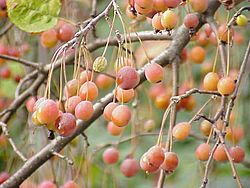Maloideae facts for kids
Quick facts for kids Maloideae |
|
|---|---|
 |
|
| Malus sikkimensis fruit | |
| Scientific classification | |
| Kingdom: | |
| Division: | |
| Class: | |
| Order: | |
| Family: | |
| Subfamily: | |
Imagine a big family of plants called the rose family. The Maloideae used to be a special group, or subfamily, within this family. These plants are usually shrubs or small trees.
The most famous members of this group are apples and pears! You might be surprised to learn that many other fruits like quince, loquat, and hawthorn also belong here.
Scientists who study plants, called botanists, have learned new things about how plants are related. They found that the Maloideae group is actually part of a larger, older subfamily called Amygdaloideae. Because of this new understanding, most botanists don't use the name Maloideae anymore. They now include these plants under the Amygdaloideae subfamily.
Contents
What are Maloideae?
The plants once known as Maloideae are part of the huge Rosaceae family. This family includes many well-known plants, from roses to strawberries. The Maloideae group was special because its members often have a unique type of fruit called a pome.
Pome Fruits Explained
A pome is a fruit where the fleshy part we eat comes from the plant's flower parts, not just the ovary. Think of an apple: the core is where the seeds are, and the juicy part around it is the pome. This is different from fruits like peaches or cherries, where the fleshy part comes directly from the ovary.
Examples of Pome Fruits
Some common pome fruits that were once grouped under Maloideae include:
- Apples: One of the most popular fruits worldwide.
- Pears: Sweet and juicy, often bell-shaped.
- Quince: A hard, fragrant fruit often used in jams and jellies.
- Loquat: A small, sweet, yellowish-orange fruit.
- Hawthorn: Small, berry-like fruits from a thorny shrub.
Why the Name Changed
For a long time, botanists classified plants based on what they looked like. The Maloideae group was created because these plants shared similar features, especially their pome fruits.
Modern Plant Classification
Today, scientists use more than just looks. They also study the DNA of plants. DNA is like a plant's instruction manual. By comparing DNA, scientists can see how closely different plants are related.
DNA Evidence and New Groupings
DNA studies showed that the plants in Maloideae are very closely related to other plants in the Amygdaloideae subfamily. This subfamily includes plants like almonds, plums, and cherries. Because of this strong DNA evidence, scientists decided to combine Maloideae into Amygdaloideae. This makes the plant family tree more accurate.
Images for kids
See also
 In Spanish: Maloideae para niños
In Spanish: Maloideae para niños


